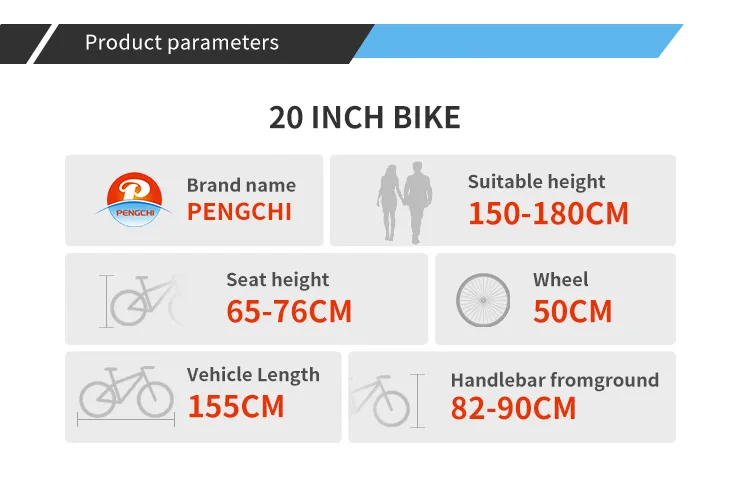2 月 . 03, 2025 01:37 Back to list
different types of mountain bikes
Exploring the diverse world of mountain bikes can be both exhilarating and technical. As an avid cyclist or someone looking to enter the sport, understanding the different types of mountain bikes is crucial to making an informed purchase and maximizing your riding experience. Whether you're navigating rocky terrains, climbing steep slopes, or zooming down trails, each type of mountain bike offers distinct features tailored to specific biking environments and riding styles.
Downhill (DH) Bikes Downhill bikes are purpose-built for plummeting down steep, technical descents at high speeds. With suspension travel reaching upwards of 200mm, these bikes are the epitome of rugged and robust design. Their geometry focuses on stability, featuring very slack head angles and long wheelbases to ensure maximum control at high speeds. Downhill bikes are heavier, designed to cope with the harsh impacts and stresses of high-gradient trails. This makes them less effective for uphill travel but unmatched in downhill performance. Serious downhill enthusiasts and competitive racers will appreciate the durability and focus of a DH bike for extreme downhill challenges. Fat Bikes Fat bikes are characterized by their oversized tires, generally measuring four inches or more in width. These bikes are the go-to choice for riding on soft and unstable surfaces where conventional tires would falter, such as snow, sand, or loose gravel. The large contact patch and low tire pressure offer unparalleled flotation and grip, allowing riders to traverse challenging terrains with ease. The unique capability of fat bikes to handle diverse off-road conditions makes them ideal for adventure seekers and those who ride year-round in varying weather and terrain conditions. Electric Mountain Bikes (e-MTBs) Electric mountain bikes, or e-MTBs, have gained popularity for providing an extra boost through pedal-assist motors. They are designed to extend the range and accessibility of mountain biking, making climbs less daunting and enabling longer rides with reduced fatigue. Available in versions that parallel the traditional categories—such as trail, enduro, and full suspension—these bikes offer varying levels of assistance tailored to different riding preferences. For those looking to ease back into biking, tackle more challenging terrain, or simply enjoy extended rides without as much physical exertion, e-MTBs provide an exciting alternative. Each type of mountain bike offers its own unique advantages, and choosing the right one depends on the rider's preferences, the nature of the terrain, and the specific biking goals one aims to achieve. An informed choice not only enhances your enjoyment but also elevates your performance across the trails. Whether your heart races at the thought of cross-country expeditions or jumps at the thrill of downhill plunges, there’s a mountain bike perfectly suited to fuel your passion.


Downhill (DH) Bikes Downhill bikes are purpose-built for plummeting down steep, technical descents at high speeds. With suspension travel reaching upwards of 200mm, these bikes are the epitome of rugged and robust design. Their geometry focuses on stability, featuring very slack head angles and long wheelbases to ensure maximum control at high speeds. Downhill bikes are heavier, designed to cope with the harsh impacts and stresses of high-gradient trails. This makes them less effective for uphill travel but unmatched in downhill performance. Serious downhill enthusiasts and competitive racers will appreciate the durability and focus of a DH bike for extreme downhill challenges. Fat Bikes Fat bikes are characterized by their oversized tires, generally measuring four inches or more in width. These bikes are the go-to choice for riding on soft and unstable surfaces where conventional tires would falter, such as snow, sand, or loose gravel. The large contact patch and low tire pressure offer unparalleled flotation and grip, allowing riders to traverse challenging terrains with ease. The unique capability of fat bikes to handle diverse off-road conditions makes them ideal for adventure seekers and those who ride year-round in varying weather and terrain conditions. Electric Mountain Bikes (e-MTBs) Electric mountain bikes, or e-MTBs, have gained popularity for providing an extra boost through pedal-assist motors. They are designed to extend the range and accessibility of mountain biking, making climbs less daunting and enabling longer rides with reduced fatigue. Available in versions that parallel the traditional categories—such as trail, enduro, and full suspension—these bikes offer varying levels of assistance tailored to different riding preferences. For those looking to ease back into biking, tackle more challenging terrain, or simply enjoy extended rides without as much physical exertion, e-MTBs provide an exciting alternative. Each type of mountain bike offers its own unique advantages, and choosing the right one depends on the rider's preferences, the nature of the terrain, and the specific biking goals one aims to achieve. An informed choice not only enhances your enjoyment but also elevates your performance across the trails. Whether your heart races at the thought of cross-country expeditions or jumps at the thrill of downhill plunges, there’s a mountain bike perfectly suited to fuel your passion.
Previous:
Latest news
-
Toy Car with Parental Remote - Safe Electric Ride-On Car with Parental Control
NewsJun.10,2025
-
Cheap Bikes for Students - Affordable & Durable Student Bicycles Online
NewsJun.10,2025
-
Children Balance Bike Lightweight & Adjustable OEM Designs
NewsMay.30,2025
-
Junior BMX Race Bikes Lightweight, Durable & Speed-Optimized
NewsMay.30,2025
-
21-Speed Foldable Gear Cycle Compact & Portable Commuter Bike
NewsMay.30,2025
-
Affordable & Durable Bikes for Students Campus Commutes Made Easy
NewsMay.29,2025



